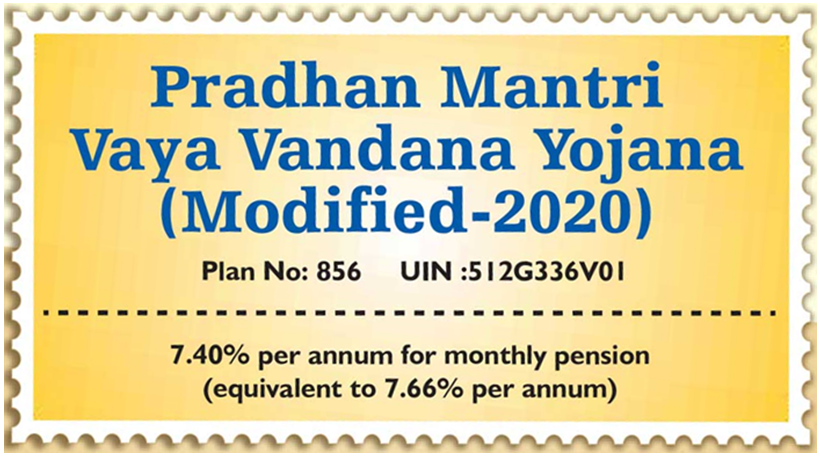Pradhan Mantri Vaya Vandana Yojana (PMVVY) is an insurance policy-cum- pension scheme that was launched by the government of India, especially for the senior citizens aged 60 years and above. One can invest a maximum of Rs 15 lakh under this scheme on or before 31st March 2023. This scheme can be bought through online or offline modes from Life Insurance Corporation of India and caters to one’s financial needs after their retirement.
Features and Benefits of Pradhan Mantri Vaya Vandana Yojana (PMVVY)
- Assurance of returns: Under the Pradhan Mantri Vaya Vandana Yojana, the pensioner will receive an assured return of 7.4% per annum once the policy term of 10 years is over.
- Periodic payout options: Individuals will be able to choose among monthly, quarterly, half-yearly, or annual payout with the plan as per their convenience. The first payment should be done immediately after one buys the plan, based on his/her chosen payment mode.
- Maturity benefit: PMVVY scheme also comes with a maturity benefit. If the pensioner survives the term of the policy, he/she will receive a lump-sum purchase price as well as the final installment payout.
- Death benefit: In case the pensioner dies during the policy period, his/her beneficiary can claim the total purchase amount by submitting the required documents.
- Free-look period: After buying the policy, if the policyholder is not satisfied with the terms of the policy, they can return this scheme within 30 days from the date of receipt if they have purchased it online. However, the free-look period is 15 days if the policy is purchased offline. After deducting the stamp fees, the purchase price will be refunded to the policyholder.
- Loan facility: Under this scheme, once the policyholder completes 3 successful years, the pensioner can avail loans against the policy. He/she can borrow a maximum of 75% of the purchase price as a loan. The interest calculated on the loan will be recovered from the pension payment that is made.
- Surrender value: The pensioner can also surrender the policy in case they want to avail of the treatment of critical illnesses for self or spouse. He/she will receive 98% of the purchase amount if they surrender the policy before its tenure is over.
- Exclusion: PMMVY scheme also comes with an exclusion feature. Under this feature, the entire policy’s purchase price will be paid if a policyholder dies by suicide.
Eligibility criteria and other conditions
| Minimum Entry Age | Maximum Entry Age | Minimum Pension that is earned | Maximum Pension that can be earned | Duration of the policy |
| 60 years and above | There is no limit | ● Rs.1,000 per month
● Rs.3,000 per quarter ● Rs.6,000 per half-year ● Rs.12,000 per year |
● Rs.10,000 per month
● Rs.30,000 per quarter ● Rs.60,000 per half-year ● Rs.1,20,000 per year |
10 years |
While choosing the maximum pension ceiling, the individual must consider the entire family. The family under the PMVVY scheme consists of the pensioner, his/her spouse, and dependents.
PMVVY Scheme Extention
Pradhan Mantri Vaya Vandana Yojana (PMVVY) was earlier available from 4th May 2017 to 31st March 2020. But on 20th May 2020, the government has announced its extension. PMVVY scheme has now been further extended by the government for another three financial years till 31st March 2023.
Updates to PMVVY (May 20, 2020)
The government of India released a press statement on 20th May 2020 where it extended the PMVVY scheme for a further period of 3 years, i.e. until 31st March 2023. It also modified the pension rates of the PMVVY scheme. The interest rate of the PMVVY scheme for the financial year 2020-21 has been fixed at 7.4%, and this interest rate will keep changing every financial year. The press release further stated that the annual reset of the assured interest rate will be effective from the 1st April of the financial year, in accordance with the modified rate of returns of Senior Citizens Saving Scheme up to a ceiling of 7.75%.
Mode of Pension Payment
The different modes of pension payment available under the PMVVY scheme are monthly, quarterly, half-yearly & yearly. You can make the payment through Aadhaar Enabled Payment System or National Electronics Fund Transfer. Depending on the mode of pension payment, the first installment of pension must be paid within 1 month, 3 months, 6 months, or 1 year from the date the policy was purchased.
Purchase Price Payment in PMVVY Scheme
Individuals can buy the PMVVY scheme by paying a lump sum purchase price. The pensioner will get the option to choose between the amount of purchase price and the pension amount he/she will receive. The minimum and maximum pension prices under the different modes of pension are listed below:
Minimum purchase price under different modes of pension
| Pension Mode | Minimum purchase price (in Rs.) | Corresponding pension amount |
| Monthly | 1,62,162 | 1,000 per month |
| Quarterly | 1,61,074 | 3,000 per quarter |
| Half-yearly | 1,59,574 | 6,000 per half-year |
| Yearly | 1,56,658 | 12,000 p.a. |
Maximum purchase price under different modes of pension
| Pension Mode | Maximum purchase price (in Rs.) | Corresponding pension amount |
| Monthly | 15,00,000 | 9,250 per month |
| Quarterly | 14,89,933 | 27,750 per quarter |
| Half-yearly | 14,76,064 | 55,500 per half-year |
| Yearly | 14,49,086 | 1,11,000 p.a. |
Should you invest in PMVVY Scheme?
If you are a risk-averse investor and want to invest in a long-term regular income plan then Pradhan Mantri Vaya Vandana Yojana should be your first choice. If you park money in the PMVVY scheme at the current interest rate of 7.40% per annum, you will receive payouts for the full term of 10 years. However, the PMVVY scheme does not enable an investor to claim for deductions under section 80C of the Income Tax Act since it is not an eligible investment.
Pradhan Mantri Vaya Vandana Yojana is a good choice when chances of interest rates going higher are less but liquidity in the PMVVY scheme is limited.
Also Read: Public Provident Fund (PPF): Interest Rate, Features & Benefits
Premature Exit in PMVVY
Premature exit from the PMVVY scheme is only permitted if the policyholder needs money to avail treatment of any terminal/critical illness of self or his/her spouse. In such cases, there shall be a premature exit penalty of 2%. The remaining 98% of the purchase price will be paid back to the pensioner.
How is Pension Income taxed in PMMVY Scheme?
Pension income in Pradhan Mantri Vaya Vandana Yojana is taxed at the policyholder’s marginal income tax rate. Once the purchase value is returned at the time of maturity or death of the policyholder, no tax will be charged.
How to invest in PMVVY Scheme?
Individuals can purchase the PMVVY scheme via both online and offline modes.
Offline mode
To buy the scheme via offline mode, you need to visit the nearest branch of Life Insurance Corporation of India (LIC). After deciding the purchase amount or pension payment, you will have to fill up the application form and submit it along with the necessary documents and the preferred amount.
Online mode
1) Visit the official website of LIC https://www.licindia.in/
2) Now, tap on the “Pradhan Mantri Vaya Vandana Yojana” button under the ‘Buy Policy Online’ header.
3) Next, select on the ‘Click to Buy Online’ button.
4) Fill in your personal details like name, mail ID, phone number, birth date, and residential address, etc. Now, you will receive a 9 digit Access ID either through SMS in your registered phone number or by mail.
5) Submit the Access ID and tap on the ‘Proceed’ button to go forward with the application.
6) Next, choose the pension plan under PMVVY, upload the scanned copies of the essential documents, and pay the application fee.
7) Once you have successfully submitted the application form, you will be given an acknowledgment and policy number.
Documents required to apply for PMVVY Scheme
- PAN Card
- Valid address proof like Passport or Aadhaar Card
- Submit a photocopy of the cheque leaf or the bank passbook’s first page. The pension amount will be credited to that account every month.
Pros & Cons of PMVVY Scheme
Pros of PMVVY Scheme
- PMVVY is a retirement scheme that does not have many risk factors. The scheme’s interest rates will not change throughout its investment period, and the pensioners can avail a maximum of 75% of the purchase price as a loan after completing three years of the policy.
- It also provides stable returns of 7.40% p.a. which is preferable in the circumstances of falling interest rates.
Cons of PMVVY Scheme
- PMVVY does not offer income tax benefits on investments made under this scheme.
- The interest income under this scheme is taxable that reduces its overall returns.
- PMVVY scheme has a longer lock-in period of 10 years.
Difference between SCSS & PMVVY
| Pradhan Mantri Vaya Vandana Yojana (PMVVY) | Senior Citizens Savings Scheme (SCSS) |
| PMVVY scheme comes with a lock-in period of 10 years. | SCSS has a lock-in period of five years. |
| PMVVY provides regular income on a monthly, quarterly, half-yearly, and annual basis | SCSS provides regular income only on a quarterly basis. |
| PMVVY scheme does not offer income tax benefits. | SCSS offers income tax benefits under Section 80C of the Income Tax Act. |
Conclusion
Pradhan Mantri Vaya Vandana Yojana intends to offer senior citizens with a regular pension during the period when there is a fall in interest rates. It is a form of alternate income of the senior citizens in our country.
Also Read: Sukanya Samriddhi Yojana vs FDs: Which one is better?
FAQs on PMVVY
Latest posts by Nirupama Verma (see all)
- What is Corporate Gifting and Why is It Important? - November 8, 2023
- Top 5 Benefits of Synthetic Liquids That You Did Not Know - December 24, 2022
- Pin up Review - September 23, 2022





If anyone want to invest money for a long term, so the Pradhan Mantri Vaya Vandana Yojna is best. This whole post provide very accurate information
Thanks to the author’s comprehensive description, I learnt everything I needed to know about my topic after reading this post. I published a review that you may read on the domyessay reviews. Thank you so much for your time and attention.